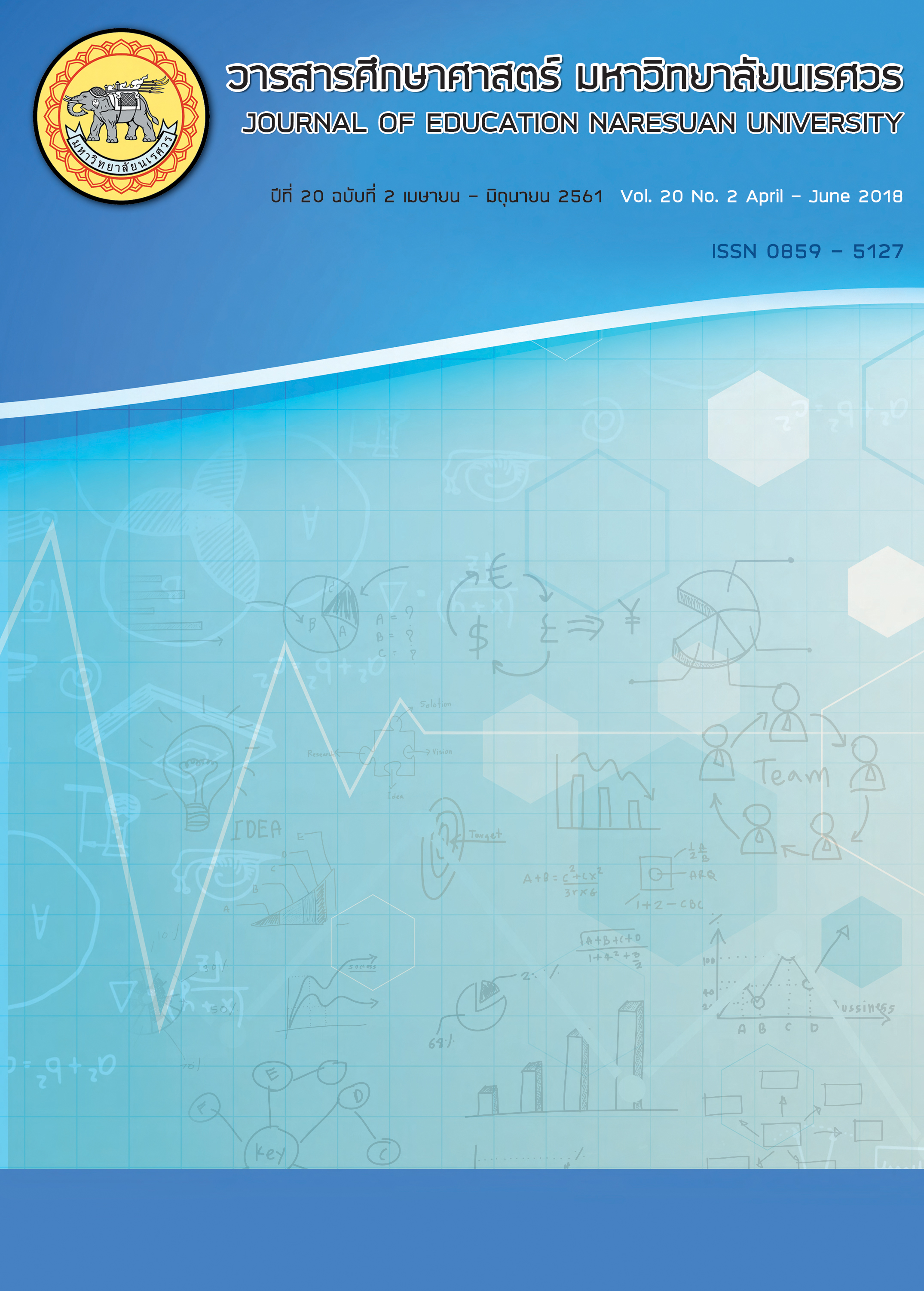รูปแบบการประเมินภาวะผู้นำของครูในสถานศึกษาขั้นพื้นฐาน สังกัดสำนักงานเขตพื้นที่การศึกษามัธยมศึกษา; AN EVALUATION MODEL OF TEACHER LEADERSHIP IN BASIC SCHOOL UNDER THE SECONDARY EDUCATIONAL SERVICE AREA OFFICE
Main Article Content
Abstract
การวิจัยครั้งนี้มีวัตถุประสงค์ เพื่อพัฒนารูปแบบการประเมินภาวะผู้นำของครูในสถานศึกษาขั้นพื้นฐาน สังกัดสำนักงานเขตพื้นที่การศึกษามัธยมศึกษา วิธีดำเนินการวิจัยมี 3 ขั้นตอน คือ ขั้นตอนที่ 1การศึกษาภาวะผู้นำของครู และแนวทางการประเมินภาวะผู้นำของครูในสถานศึกษา โดยการสังเคราะห์เอกสารและสัมภาษณ์ผู้ทรงคุณวุฒิ จำนวน 14 คน ขั้นตอนที่ 2 การสร้างรูปแบบการประเมินภาวะผู้นำของครูในสถานศึกษา ประเมินความเหมาะสมโดยการประชุมสนทนากลุ่มของผู้ทรงคุณวุฒิจำนวน 9 คน ขั้นตอนที่ 3 การประเมินความเหมาะสมและความเป็นไปได้ของรูปแบบการประเมินภาวะผู้นำของครูในสถานศึกษา โดยใช้แบบสอบถาม ผู้ให้ข้อมูล คือผู้บริหารการศึกษาและผู้บริหารสถานศึกษา จำนวน 325 คน ผลการวิจัย พบว่า รูปแบบการประเมินภาวะผู้นำของครูในสถานศึกษาขั้นพื้นฐาน สังกัดสำนักงานเขตพื้นที่การศึกษามัธยมศึกษา มี 5 องค์ประกอบ ได้แก่ องค์ประกอบที่ 1 สิ่งที่มุ่งประเมิน คือ ภาวะผู้นำของครู มี 5 ด้าน ได้แก่ ด้านการริเริ่มการเปลี่ยนแปลง ด้านความสามารถทางหลักสูตรและการสอน ด้านการพัฒนาผู้เรียน ด้านการพัฒนาตนเองและเพื่อนร่วมงาน และด้านคุณลักษณะพื้นฐาน องค์ประกอบที่ 2 วิธีการประเมิน มี 2 วิธี ได้แก่ การประเมินพฤติกรรมการปฏิบัติงาน และการตรวจสอบรายการ องค์ประกอบที่ 3 ผู้ทำการประเมิน มี 5 ประเภท ได้แก่ ผู้บังคับบัญชา เพื่อนร่วมงาน ตนเอง นักเรียนที่ทำการสอน และศึกษานิเทศก์ องค์ประกอบที่ 4 เกณฑ์การประเมิน ประกอบด้วย ระดับคุณภาพ และร้อยละ และองค์ประกอบที่ 5 การสะท้อนผลการประเมิน ประกอบด้วย ลักษณะการสะท้อนผลการประเมิน และวิธีสะท้อนผลการประเมิน ผลการประเมินรูปแบบ พบว่ารูปแบบการประเมินภาวะผู้นำของครูในสถานศึกษาขั้นพื้นฐาน สังกัดสำนักงานเขตพื้นที่การศึกษามัธยมศึกษา มีความเหมาะสมและความเป็นไปได้อยู่ในระดับมาก
AN EVALUATION MODEL OF TEACHER LEADERSHIP IN BASIC SCHOOL UNDER THE SECONDARY EDUCATIONAL SERVICE AREA OFFICE
The objectives of this research were to develop an evaluation model of teacher leadership in basic school under the secondary educational service area office. Research procedure follows 3 steps as follows; 1) Studying teacher leadership and guidelines for evaluating the teacher leadership in basic school through related document analysis and synthesis, and interview 14 experts, 2) constructing an evaluation model of teacher leadership in basic school under the secondary educational service area office by focus group discussion technique of 9 experts, and 3) evaluating the appropriateness and feasibility of the model. The instrument was questionnaire and the samples were 325 principles and directors of the secondary educational service area office. Finding showed that an evaluation model of teacher leadership in basic school under the secondary educational service area consisted of 5 components; 1) Domains of evaluation: initiations of change, ability to design curriculum and instruction, student development, self and colleagues development, fundamental personality traits, 2) procedure for evaluation: check-list and Behaviorally anchored rating scales, 3) assessors: administrators, colleague, self, student, educational supervisor, 4) criteria for evaluation: quality, percentage, and 5) feedback: types of feedback, and method of giving feedback. An evaluation model of teacher leadership in basic school under the secondary educational service area office was appropriate and feasible at a high level.
Article Details
The owner of the article does not copy or violate any of its copyright. If any copyright infringement occurs or prosecution, in any case, the Editorial Board is not involved in all the rights to the owner of the article to be performed.
References
Hannakin, P. (1999). Personel administration. Bangkok: Chulalongkorn University Press. (in Thai)
Hattie John. (2012). Visible learning for teachers Routledge (New York and London). British Journal of Educational Technology, 43(4), 134-136.
Kanjanawasee, S. (2002). Evaluation theory (3rd ed.). Bangkok: Chulalongkorn University Press. (in Thai)
Office of the Basic Education Commission. (2010). A competency for the evaluation of teacher guideline (Revised edition B.E. 2553). Retrieved July 5, 2014, from https://gpa.tmk.ac.th/teacher/capasity.pdf (in Thai)
Office of the Education Council. (2013). The analysis of teacher professional development status and guidelines for teacher professional development. Bangkok: Prikwarn Graphic. (in Thai)
Onnuam, W., Junsira, V., Mejang, S, & Parnichparinchai, T. (2016). A developmental model for enhancing primary teachers’ competencies under the office of education service areas. Journal of Education Naresuan University, 18(3), 292-302. (in Thai)
Phannitamai, W. (1997). Personnel evaluation of 360 degree feedback ratings. Government Journal, 42(4), 46-70. (in Thai)
Reimers, E. V. (2003). Teacher professional development: An international review of the literature. Paris: IIEP’s Printshop.
Rumagama, P. (2008). Performance appraisal (3rd ed). Bangkok: Thammasat Business School. (in Thai)
Sangmeesuk, S., Wannasri, J., Chansila, W., & Mejang, S. (2014). A model for competency development of teacher in school under the jurisdiction of primary educational service area office. Journal of Education Naresuan University, 16(2), 119-128. (in Thai)
Sriwichairat, W. (2010). The teacher quality and Educational Quality. Retrieved July 20, 2014, from www.escd.or.th/escd/document/seminar/.../teacher_leader.doc (in Thai)
Techacupt, P., & Kaengkun, P. (2008). Teacher competency and development of teachers in a changing society. Bangkok: Office of the Education Council, Ministry of Education. (in Thai)
Wedchayanon, N. (2000). Personnel evaluation. Bangkok: Sematham. (in Thai)
Wichitputchraporn, W. (2004). A development of model of decentralized education management in basic education schools based on the national educational Act B.E. 2542 (Doctoral dissertation). Bangkok: Chulalongkorn University. (in Thai)


